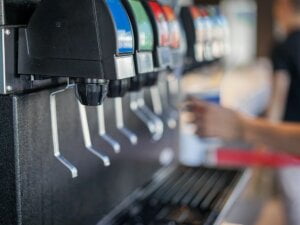It is very important for us to know about the 7 Side Effects of Soda. America’s soda addicted. For more than half of us every day, sweet, carbonated soda is the preferred drink. Sadly, soda is filled with additional sugars that cause health problems. In the end, because of any of these harmful side effects of soda, you might want to replace your drink.
It’s really very surprising what drinking sugary beverages can do to the body over time.
Excluding the reality that a typical 12-ounce drink will contain an average of 39 grams of sugar—more than three times the volume in a Krispy Kreme glazed doughnut.
 According to the CDC, 49 percent of U.S. adults drink at least one regular soda or other sweetened product per day, adding up to a tonne of calories, sugar, and body weight each year. While soda sweetened with sugar or high-fructose corn syrup has its own collection of risks, including high diabetes risk and tooth decay, diet soda is no better. Really, research suggests dietary soda consumers are more likely to add weight and have greater waist sizes. That’s not positive stuff.
According to the CDC, 49 percent of U.S. adults drink at least one regular soda or other sweetened product per day, adding up to a tonne of calories, sugar, and body weight each year. While soda sweetened with sugar or high-fructose corn syrup has its own collection of risks, including high diabetes risk and tooth decay, diet soda is no better. Really, research suggests dietary soda consumers are more likely to add weight and have greater waist sizes. That’s not positive stuff.
So, if you want to move down the right track toward healthier lives, remember these potential side effects of soda that can make you give up the sweet things.
However, being aware of these 7 side effects of soda can help you quit for good.
1/7 Obesity
 Obesity is the first of 7 side effects of soda. It’s certainly no wonder that drinking soda has been attributed to obesity. Although this may be attributed in part to the high-calorie foods that often surround sodas and fizzy drinks, a single can of soda contains 140 calories but is almost certain to have little relief from hunger. If you drink a soda for every meal for 30 days, you could add more than three pounds by the end of the month. Related: Here’s a cocktail that’s much worse for you than soda.
Obesity is the first of 7 side effects of soda. It’s certainly no wonder that drinking soda has been attributed to obesity. Although this may be attributed in part to the high-calorie foods that often surround sodas and fizzy drinks, a single can of soda contains 140 calories but is almost certain to have little relief from hunger. If you drink a soda for every meal for 30 days, you could add more than three pounds by the end of the month. Related: Here’s a cocktail that’s much worse for you than soda.
2/7 Diabetes
 Do you believe that converting to diet soda would improve your blood sugar levels? Reconsider! Standard and diet soda use have also been attributed to an uptick in type 2 diabetes. Soda’s sugar surge forces the body to convert the sugar into fat in the liver. Over the course of six months, the fat deposits in the liver could have risen by up to 150 per cent, raising the risk factor for diabetes. Similarly, according to studies reported in the Yale Journal of Biology and Medicine, artificial sweeteners may potentially raise your cravings for real sugar, placing you at a higher risk for diabetes. Begin reducing the chance of cardiovascular disease today by eliminating the 50 worst foods for diabetes.
Do you believe that converting to diet soda would improve your blood sugar levels? Reconsider! Standard and diet soda use have also been attributed to an uptick in type 2 diabetes. Soda’s sugar surge forces the body to convert the sugar into fat in the liver. Over the course of six months, the fat deposits in the liver could have risen by up to 150 per cent, raising the risk factor for diabetes. Similarly, according to studies reported in the Yale Journal of Biology and Medicine, artificial sweeteners may potentially raise your cravings for real sugar, placing you at a higher risk for diabetes. Begin reducing the chance of cardiovascular disease today by eliminating the 50 worst foods for diabetes.
3/7 Tooth Decay

A single 12-ounce can of soda contains almost ten packets of sugar, which coats your teeth and gums every time you open it. In fact, several experiments have shown how damaging soda can be to the teeth; if exposed to soda for an extended period of time, human teeth can melt. Unfortunately, contrary to what some toothpaste makers say, tooth enamel cannot be regrown after it has been eroded—once it’s gone, it’s gone for good.
4/7 Receding Gums

Receding Gums is the fourth of 7 side effects of soda. If you notice that your gum line is receding faster than your hair, it’s possible that your soda habit is to blame. Sugars, preservatives, and artificial colors used in most sodas will get stuck under your gums. If the region is not properly washed, bacteria feed on the stuck debris, causing deterioration, infection, and loss of gum tissue, which is virtually difficult to regenerate. Giving up soda now, though, will reduce the chance of receding gums and keep your smile safe and vibrant as you age. Related: 25 Foods You Didn’t Know Were Good for Your Teeth
5/7 Excess Belly Fat
 Can you have a spare tire? You should blame that on your soda habit. Soda’s refined sugar is easily consumed, creating an increase in blood sugar. This sudden increase in blood sugar stimulates the development of insulin, which can quickly convert the sugar into fat—particularly those extra pounds around your waist. Fortunately, cutting out soda from your diet can save you thousands of calories and hundreds of thousands of grams of sugar per year, which can help you lose belly fat. 15 Flat-Belly Tips from a Nutritionist Who Loses 100 Pounds
Can you have a spare tire? You should blame that on your soda habit. Soda’s refined sugar is easily consumed, creating an increase in blood sugar. This sudden increase in blood sugar stimulates the development of insulin, which can quickly convert the sugar into fat—particularly those extra pounds around your waist. Fortunately, cutting out soda from your diet can save you thousands of calories and hundreds of thousands of grams of sugar per year, which can help you lose belly fat. 15 Flat-Belly Tips from a Nutritionist Who Loses 100 Pounds
6/7 Joint Pain
 Those nagging aches and pains could be worsening any time you put a sugary drink in your shopping cart. According to the American Journal of Clinical Nutrition, women who frequently drink sugar-sweetened soda have an elevated chance of rheumatoid arthritis, so there’s no better time than the present to exclude soda from your diet.
Those nagging aches and pains could be worsening any time you put a sugary drink in your shopping cart. According to the American Journal of Clinical Nutrition, women who frequently drink sugar-sweetened soda have an elevated chance of rheumatoid arthritis, so there’s no better time than the present to exclude soda from your diet.
7/7 Kidney Health Issues

Kidney Health Issues is the last of 7 side effects of soda. Kidney stones are the product of an accumulation of minerals in the kidneys through time and gradually travel into the urethra, which is sometimes referred to as the most painful pressure on either side of childbirth. Unfortunately, people that drink soda on a daily basis are more likely to develop this painful condition; both heavy sugar intake and vomiting are linked to an elevated risk of kidney stones, and soda contributes to both.
Soft drinks and sodas: their harmful effects on our health
Did you know that a liter of soda contains the equivalent of 22 to 24 cubes of sugar? Discover the many risks of carbonated drinks and their harmful effects.

Soft drinks and sodas have negative health consequences.
The craze for soft beverages goes back to the 18th century and the invention of natural mineral waters. Originally used to soften the aftermath of over-watered parties, they never went out of fashion. The average North American consumes 182 liters a year and Europeans are getting dangerously close to it.
The terms “carbonated sweet drink” or “soda” designate any non-alcoholic drink which generally contains carbon dioxide, water, sugar (or an artificial sweetener), natural or artificial flavors which give it its identity, one or more dyes, and sometimes also caffeine.
With the exception of sugar and caffeine, which are stimulants, sodas, and soft drinks, the vast majority do not contain any nutrients. A 250ml can of cola provides about 100 calories. And if it is in the “diet” version (with sweeteners), less than 10, but without more nutrients than the original version.
Soda is one of the foods nutritionists never eat and best avoided.

Consequences and negative impacts on our health
It is okay to afford a soda every now and then, but regular consumption easily leads to the obesity problem.
It also harms the teeth, because the sugar in sodas maintains bacteria, agents of cavities. Many sodas also contain acids (phosphoric, citric acids, etc.), which attack tooth enamel.
Take the time to read the list of ingredients to fully understand what you absorb while drinking your favorite soda. Colas are very high in phosphorus, inhibiting calcium absorption. There’s also a danger that soft drinks can overtake milk, particularly among youth. However, puberty and adolescence are lifetimes. When calcium need rises to maintain skeletal growth and bone density.
In addition, you should know that, by drinking two large glasses (35 to 40 cl) of cola, a child weighing 27 kg absorbs 50 mg of caffeine. Which is equivalent to two good cups of coffee for a man of 80 kg! The arousal effect is often seen in children who are restless or who cannot fall asleep.
In adults, too much caffeine can promote high blood pressure and arrhythmia. Those prone to it have an interest in choosing a “caffeine-free” cola.
Fruit juice-flavored soft drinks are no better for you. When we closely read the bottle, we can find that more information. It contains at most 10 percent fruit juice but in particular sugar and coloring.
You will be surprised how eating a diet that is too high in sugar transforms your brain.

Recommendations
In brief, carbonated beverages ingested in moderation are not dangerous. The real danger lies in the quantity. They calm the appetite, without providing any nutrients. Children who start a meal with a sugary drink often have less appetite for healthy foods.
However, for patients who cannot take solid or liquid food. It is often recommended to drink a sugary soft drink for energy. In case of nausea, a few sips of cola can sometimes bring relief.
It’s easier to resist a food than it is to burn calories after eating it! Here is what doctors say you need to know about weight loss.

The perilous mixture of sodas and fast food
One explanation for obesity is the practice of drinking sugar-carbonated beverages and very fatty foods. The sugar in the drink causes the pancreas to produce insulin, and the insulin signals the body to store fat. In the meantime come the hamburger and fries. Because the food needs more insulin, the body retains fat instead of burning it.
We unveil the secrets that fast food restaurant workers don’t want to talk about.

Obesity and soft drink sodas
You may create healthy carbonated beverages at home. You can make by mixing sodium-low natural carbonated mineral water with a little fruit juice, nectar, or syrup sold anywhere. The study, conducted by the Boston Children’s Hospital, followed 548 school-aged children (11-12 years) for 2 years.
After each sugary drink that these children drank at that time, their body mass index increased; in addition, their risk of obesity increased by 60%. These results remained constant regardless of initial body mass, diet, number of hours spent watching television, or physical activity. One explanation for this phenomenon could be that when we eat a lot during a meal or between meals. And we spontaneously tend to eat less at the next meal. However, as additional calories arrive from sugar drinks, something persists as though the body doesn’t take them into consideration. In addition, there is no reduction in calorie intake at the next meal to compensate.
Losing weight is a complex process. Find out more about the things you should know about obesity.

How to make healthier sodas
In your own home, you will make great carbonated drinks. You can make by mixing sodium-free natural carbonized mineral water with a little fruit juice, nectar, or syrup available anywhere.
For example, do not hesitate to test these drinks and smoothies to lose weight effortlessly!